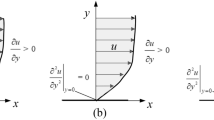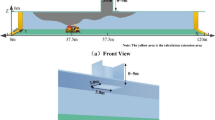Abstract
A series of experiments and simulations were conducted to investigate the effect of lateral smoke exhaust in tunnel fires. A special phenomenon, plug-holing was observed. Combined with the exhaust vent size, heat release rate and exhaust velocity, the plug-holing was analyzed. The smaller the heat release rate and the greater the exhaust velocity will enhance the plug-holing. On the contrary, the narrow exhaust vent will help to inhibit the occurrence of plug-holing. At the same time, it is found that the Froude number criterion proposed by Hinkley is not suitable for lateral smoke exhaust system. In this paper, considering the difference between lateral smoke exhaust and ceiling smoke exhaust, the Froude number proposed by Hinkley is modified to determine the plug-holing in lateral smoke exhaust, and a new modified Froude number is established. The results show that when the new modified Froude number is greater than 2.5, the plug-holing of the lateral smoke exhaust will happen at the smoke layer. The new modified Froude number might be more accurate compared with the existing criteria to judge the occurrence of plug-holing for lateral smoke exhaust.












Similar content being viewed by others
Abbreviations
- A :
-
Cross-sectional area of exhaust vent (m2)
- a :
-
Length of exhaust vent (m)
- b :
-
Height of exhaust vent (m)
- c p :
-
Specific heat at constant pressure (J/g·K)
- D * :
-
Characteristic length of mesh (m)
- Fr :
-
Froude number
- Frn :
-
New Froude number
- g :
-
Gravitational acceleration (m/s2)
- H :
-
Height of tunnel (m)
- L :
-
Length (m)
- R :
-
Hydraulic radius of exhaust vent (m)
- \(\dot{Q}\) :
-
Heat release rate (kW)
- T :
-
Temperature (K)
- T 0 :
-
Environment temperature (K)
- ΔT :
-
Smoke temperature rise (K)
- r :
-
Integral ratio
- t :
-
Time (s)
- u :
-
Velocity of smoke (m/s)
- v :
-
Exhaust velocity (m/s)
- ρ :
-
Density (kg/m3)
- δx :
-
Size of mesh (m)
- Δ:
-
Difference between variables
- F :
-
Full scale
- M :
-
Model scale
- n :
-
New
- o :
-
Lower layer
- p :
-
Upper layer
References
Liu YL, Yang D, Xiao YM, Mao SH, Yang MJ (2018) Combining diverse driving forces for smoke control in complex urban traffic link tunnels (UTLTs) using one-dimensional flow modelling. Sustain Cities Soc 43:265–274
Tang F, He Q, Chen L, Li PC (2019) Experimental study on maximum smoke temperature beneath the ceiling induced by carriage fire in a tunnel with ceiling smoke extraction. Sustain Cities Soc 44:40–45
Yi L, Wang XF, Yang Y, Wang YX, Zhou Y (2020) A simplified mathematical model for estimating gas temperature and velocity under natural smoke exhaust in sloping city tunnel fires. Sustain Cities Soc 55:21
Lin P, Wang ZK, Wang KH, Gao DL, Shi JK, You SH, Chen ZN, Wang GY, Mei XJ (2019) An experimental study on self-extinction of methanol fire in tilted tunnel. Tunn Undergr Space Technol. https://doi.org/10.1109/ICFSFPE48751.2019.9055762
Wang YF, Li YL, Yan PN, Zhang B, Jiang JC, Zhang L (2015) Maximum temperature of smoke beneath ceiling in tunnel fire with vertical shafts. Tunn Undergr Space Technol 50:189–198
Xie BC, Han YX, Huang H, Chen L, Zhou Y, Fan CG, Liu XP (2018) Numerical study of natural ventilation in urban shallow tunnels: impact of shaft cross section. Sustain Cities Soc 42:521–537
Zhang SG, Yao YZ, Zhu K, Li KY, Zhang RF, Lu S, Cheng XD (2016) Prediction of smoke back-layering length under different longitudinal ventilations in the subway tunnel with metro train. Tunn Undergr Space Technol 53:13–21
Alarie Y (2002) Toxicity of fire smoke. Crit Rev Toxicol 32(4):259–289
He L, Xu ZS, Chen HG, Liu QL, Wang YX, Zhou Y (2018) Analysis of entrainment phenomenon near mechanical exhaust vent and a prediction model for smoke temperature in tunnel fire. Tunn Undergr Space Technol 80:143–150
Chen LF, Mao PF, Zhang YC, Xing SS, Li T (2020) Experimental study on smoke characteristics of bifurcated tunnel fire. Tunn Undergr Space Technol 98:9
Jiang XP, Liu MJ, Wang J, Li YZ (2018) Study on induced airflow velocity of point smoke extraction in road tunnel fires. Tunn Undergr Space Technol 71:637–643
Takeuchi S, Tanaka F, Yoshida K, Moinuddin KAM (2018) Effects of scale ratio and aspect ratio in predicting the longitudinal smoke-temperature distribution during a fire in a road tunnel with vertical shafts. Tunn Undergr Space Technol 80:78–91
Tao HW, Xu ZS, HeL LQL, Zhao JM, Luan D, Gong FCG (2020) A simple correlation for predicting the rise time of fire-induced smoke flow in a tunnel with longitudinal ventilation. Tunn Undergr Space Technol 98:6
Hinckley PL (1995) Smoke and heat venting. Sfpe Handbook of Fire Protection Engineering.
Lougheed GD (2001) The smoke hazard from a fire in high spaces. ASHRAE Trans 107(1):720–729
Vauquelin O (2008) Experimental simulations of fire-induced smoke control in tunnels using an “air-helium reduced scale model”: principle, limitations, results and future. Tunn Undergr Space Technol 23(2):171–178
Ji J, Li KY, Zhong W, Huo R (2010) Experimental investigation on influence of smoke venting velocity and vent height on mechanical smoke exhaust efficiency. J Hazard Mater 177(1–3):209–215
Ji J, Gao ZH, Fan CG, Zhong W, Sun JH (2012) A study of the effect of plug-holing and boundary layer separation on natural ventilation with vertical shaft in urban road tunnel fires. Int J Heat Mass Transf 55(21–22):6032–6041
Yan GF, Wang MN, Yu L, Duan RY, Xia PX (2020) Effects of ambient pressure on smoke movement patterns in vertical shafts in tunnel fires with natural ventilation systems. Build Simul 13(4):931–941
Baek D, Sung KH, Ryou HS (2017) Experimental study on the effect of heat release rate and aspect ratio of tunnel on the plug-holing phenomena in shallow underground tunnels. Int J Heat Mass Transf 113:1135–1141
Xu ZS, Liu QL, He L, Tao HW, Zhao JM, Chen HG, Li LJ, Fan CG (2019) Study on the heat exhaust coefficient and smoke flow characteristics under lateral smoke exhaust in tunnel fires. Fire Mater 43(2):857–867
Yang J, Pan X, Wang Z, Hua M, Jiang J (2018) Numerical study on the smoke flow characterization and phenomenon of plug-holing under lateral smoke exhaust in tunnel fire. J Appl Fluid Mech 11(1):115–126
Zhong W, Sun CP, Bian HT, Gao ZH, Zhao J (2021) The plug-holing of lateral mechanical exhaust in subway station: Phenomena, analysis, and numerical verification. Tunn Undergr Space Technol 112:103914
Heskestad G (1975) Physical modeling of fire. J Fire Flammabil 6:253–273
Hostikka S (2010) Fire Dynamics Simulation (Version 5) User's Guide.
Babrauskas V (2016) Heat release rates, SFPE handbook of fire protection engineering. Springer, New York, pp 799–904
He Y, Fernando A, Luo M (1998) Determination of interface height from measured parameter profile in enclosure fire experiment. Fire Saf J 31(1):19–38
Acknowledgements
This work was supported by the Natural Science Foundation of Hunan Province of China (Grant No. 2020JJ3046) and the Fundamental Research Funds for the Central Universities of Central South University (Grant No. 2021zzts235). The authors are grateful for resources from the High Performance Computing Center of Central South University.
Author information
Authors and Affiliations
Corresponding author
Additional information
Publisher's Note
Springer Nature remains neutral with regard to jurisdictional claims in published maps and institutional affiliations.
Rights and permissions
About this article
Cite this article
Liu, Q., Xu, Z., Fan, C. et al. Experimental and Numerical Study of Plug-Holing with Lateral Smoke Exhaust in Tunnel Fires. Fire Technol 60, 1357–1377 (2024). https://doi.org/10.1007/s10694-022-01241-2
Received:
Accepted:
Published:
Issue Date:
DOI: https://doi.org/10.1007/s10694-022-01241-2




